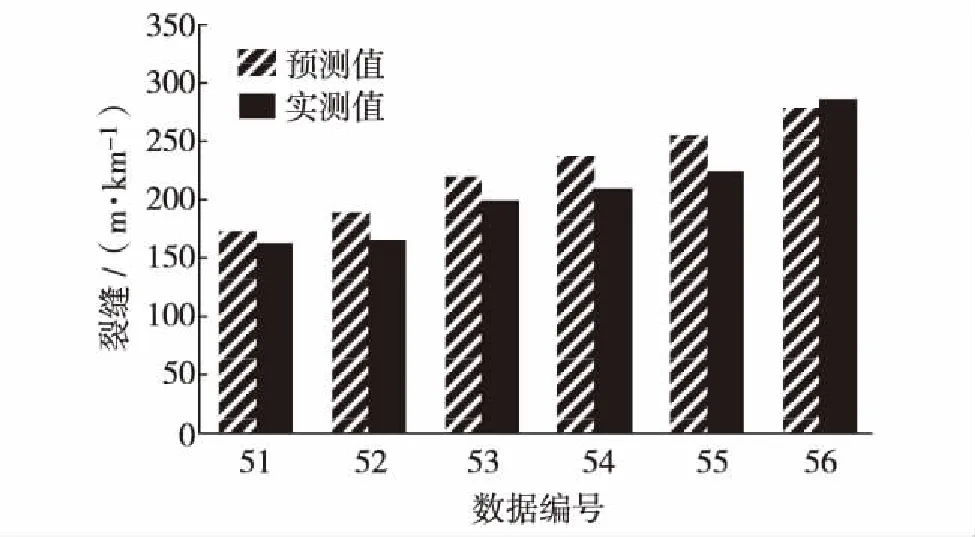基于GRNN神经网络的沥青路面裂缝预测方法
2017-07-18柯文豪陈华鑫
柯文豪,陈华鑫,雷 宇,张 涛
1) 长安大学材料科学与工程学院,陕西西安 710064;2) 中交第一公路勘察设计研究院有限公司,陕西西安 710065

【土木建筑工程 / Architecture and Civil Engineering】
基于GRNN神经网络的沥青路面裂缝预测方法
柯文豪1,陈华鑫1,雷 宇2,张 涛2
1) 长安大学材料科学与工程学院,陕西西安 710064;2) 中交第一公路勘察设计研究院有限公司,陕西西安 710065
采用相关分析法对沥青路面裂缝的不同影响因素进行分析,采用广义回归神经网络(general regression neural network,GRNN))建立沥青路面裂缝预测模型,选用50组高速公路路面实测数据对模型进行训练,选用6组实测数据对模型进行检验. 结果表明,使用年限和累计轴载次数与裂缝高度正相关;沥青层厚度、半刚性结构层厚度和上面层沥青用量与裂缝呈中度负相关;下面层沥青用量与裂缝呈低度正相关;年最低气温与裂缝相关性极弱.预测值与实测值偏差较小,裂缝预测值与实测值最大偏差为12.71%,说明模型预测效果较好.
道路工程;预测方法;裂缝;高速公路;沥青路面;广义回归神经网络
随着中国路网的逐步完善,公路修筑急速由建设期转入运营养护期. 在养护期如何保障路面长期性能优良是目前面临的一个主要问题. 从欧美等发达国家历史经验看,对路面进行合理的养护规划是解决该问题的一个有效手段. 然而无论采用何种养护规划方法,首先需要解决的是路面路用性能预测问题. 其中,裂缝作为沥青路面最主要的病害类型,对其进行科学预测尤为重要. 国外对沥青路面裂缝预测的研究较早,其中影响较大的为美国国有公路运输管理员协会(American association of state highway and transportation officials, AASHTO)路面性能预测模型,其针对沥青路面自上而下(top-down)裂缝、 自下而上(bottom-up)裂缝和温度裂缝均建立了对应的预测模型[1-7]. 然而以上模型均为通过室内试验并结合美国当地路面情况得到,由于路面结构类型、施工水平和环境交通特征与中国实际情况都存在较大差异,无法直接采用. 国内学者对路面性能预测也开展了相关研究,武建民等[8]建立了基于时间序列分析法的自回归积分滑动平均模型(autoregressive integrated moving average model,ARIMA)对路面行驶使用性能指数(riding quality index,RQI)进行预测[8];周鹏飞等[9-24]分别采用马尔可夫链与神经网络组合模型、信息扩散理论、灰色系统理论等对路面性能指数进行预测.以上预测模型主要为综合性的指数模型,并未针对裂缝预测开展相关性研究. 曾胜等[25]通过对沥青玛蹄脂碎石路面逐年裂缝的观测,采用灰色关联法建立使用年限与路面裂缝率的模型对路面裂缝进行预测,由于观测样本单一且影响因素较少,使其适用性受限.
本研究考虑环境、交通、路面结构和路面材料等因素,根据多条高速公路沥青路面历年裂缝实测数据,采用相关分析法对裂缝的不同影响因素进行分析,确定影响程度,进而采用广义回归神经网络(general regression neural network,GRNN)预测方法建立裂缝的预测模型.
1 沥青路面裂缝影响因素分析
1.1 影响因素选择及数据获取方法
影响沥青路面裂缝的因素有环境、交通、路面结构、路面材料和施工水平等.本研究选取路面使用年限、累计标准轴载作用次数、年最低气温、沥青层厚度、半刚性结构层厚度、上面层沥青用量和下面层沥青用量等作为沥青路面裂缝影响因素,并采用相关性分析方法,分析以上因素对裂缝的影响程度.
本研究选取深圳市机荷高速、南光高速、盐排高速、盐坝高速;陕西省靖王高速、西长高速、西安绕城高速、延靖高速、榆绥高速等高速公路路面设计数据及部分年限的检测数据进行分析. 其中,各路段使用年限、累计标准轴载作用次数、沥青层厚、半刚性结构层厚度、上面层沥青用量和下面层沥青用量等数据从设计文件中得到;年最低气温通过搜集项目所在地区气候数据得到;裂缝从历年路面检测资料及养护维修资料中获得.
1.2 影响因素及裂缝数据
各路段路面结构如表1,可见各路段路面结构均为半刚性基层路面, 沥青层厚度为15~22 cm, 半刚性结构层厚度为40~62 cm,与国内目前常用的路面结构形式一致.各影响因素及裂缝数据如表2.

表1 各路段路面结构

表2 各影响因素及裂缝数据

(续表2)
1.3 结果及分析
采用相关分析法分析各影响因素对沥青路面裂缝的影响程度,分析结果如表3,从表3可见,使用年限、累计轴载作用次数、年最低气温、下面层沥青用量与裂缝呈正相关;沥青层厚度、半刚性结构层厚度、上面层沥青用量与裂缝呈负相关. 其中使用年限、累计轴载作用次数与裂缝高度相关;沥青层厚度、半刚性结构层厚度、上面层沥青用量与裂缝呈中度相关;下面层沥青用量与裂缝呈低度相关;年最低气温与裂缝则相关性极弱.
随着使用年限及累计轴载作用次数的增加,路面疲劳裂缝逐步扩展,裂缝增多;沥青层厚度的增大有利于减少及降低半刚性结构层反射裂缝的扩展速率,从而减少路面裂缝;半刚性基层厚度的增大有利于提高基层整体强度,减少基层裂缝的产生,从而减少反射至路表的裂缝;上面层采用沥青用量较大的沥青玛蹄脂碎石等沥青混合料,其抗裂性能较好,有利于减少路面裂缝;下面层采用沥青碎石等沥青用量较少的沥青碎石类材料,在一定程度上有利于减少及延缓反射裂缝;路面裂缝对年最低气温的变化不敏感,其主要原因为低温对温度裂缝的影响较大,而在全国大多数区域内温度裂缝并非半刚性基层沥青路面主要裂缝形式,因此,其对沥青路面裂缝的影响有限. 相关性分析结论与工程实际情况较为吻合,说明采用相关分析法分析各因素对沥青路面裂缝的影响程度是可行的.

表3 各影响因素与裂缝之间的相关系数
2 裂缝预测
2.1 GRNN预测方法
为预测沥青路面裂缝,采用GRNN方法建立裂缝的预测模型. GRNN具有很强的非线性映射能力和柔性网络结构以及高度的容错性和鲁棒性,适用于解决非线性问题. GRNN在逼近能力和学习速度上较径向基函数(radial basis function,RBF)网络有更强的优势,网络最后收敛于样本量积聚较多的优化回归面,并且在样本数据较少时,预测效果也较好.
2.2 GRNN预测模型建立
模型建立首先需选取训练样本及测试样本. 将表2中56组样本分为训练样本及测试样本,训练样本选取第1~50组数据;测试样本选取第51~56组数据. 由于年最低气温与裂缝率的相关性极弱,故将该因素剔除后,选取使用年限、累计轴载作用次数、下面层沥青用量、沥青层厚度、半刚性结构层厚度和上面层沥青用量作为影响因素,采用GRNN神经网络建立模型,对第1~50组数据进行训练,训练均方误差为0.000 333 9,训练完成后,对第51~56组数据的裂缝率进行预测.
2.3 GRNN预测结果
将预测值与实测值进行对比,如图1和表4所示. 可以看出,裂缝预测值与实测值最大偏差为12.71%,均方根误差与实测平均值比值为11.97%,平均绝对误差与实测平均值比值为10.75%,预测值与实测值误差较小,拟合度较高. 说明采用GRNN神经网络模型对裂缝进行预测,其效果较好.

图1 神经网络预测值与实测值对比Fig.1 Comparing prediction values of neural network with measured values

误 差裂缝/(m·km-1)均方根误差27.047标准均方根误差0.056平均绝对误差24.274标准平均绝对误差0.050
3 结 论
综上研究认为:
1)采用相关分析法对裂缝的不同影响因素进行分析,结果表明,使用年限、累计轴载作用次数与裂缝高度正相关;沥青层厚度、半刚性结构层厚度、上面层沥青用量与裂缝中度负相关;下面层沥青用量与裂缝低度正相关;年最低气温与裂缝相关性极弱;
2)采用GRNN神经网络建立用于沥青路面裂缝预测的神经网络模型,可考虑交通量、温度、路面结构、路面材料等影响因素,且预测值与实测值偏差小,最大偏差为12.71%;
3)基于GRNN神经网络逼近能力强、学习速度快的特性,在后续研究中随着样本采集数的不断增大,沥青路面裂缝预测的精度也将不断提升.
/ References:
[1] Hofko B. Addressing the permanent deformation behavior of hot mix asphalt by triaxial cyclic compression testing with cyclic confining pressure[J]. Journal of Traffic and Transportation Engineering English Edition,2015,2(1):17-29.
[2] Durango P L. Adaptive optimization models for infrastructure management[D]. Berkeley, USA: University of California Berkeley,2002.
[3] Mensching D J,McCarthy L M,Mehta Y,et al. Modeling flexible pavement overlay performance for use with quality related specifications[J]. Construction and Building Materials,2013,48(6): 1072-1080.
[4] Mandapaka V. Mechanistic-empirical and life-cycle cost analysis for optimizing flexible pavement maintenance and rehabilitation[J]. Journal of Transportation Engineering,2012,138(5): 625-633.
[5] Yared H D,Ibrahim O,Denis J,et al. Mechanics-based top-down fatigue cracking initiation prediction framework for asphalt pavements[J]. Road Materials and Pavement Design,2015,16(4): 907-927.
[6] Shahab F,Ali K. Reinforcing overlay to reduce reflection cracking: an experimental investigation[J]. Geotextiles and Geomembranes,2015,43(3):216-227.
[7] Gedafa D S,Hossain M,Romanoschi S A. Perpetual pavement temperature prediction model[J]. Road Materials & Pavement Design, 2014,15(1):55-65.
[8] 武建民,刘大彬,李福聪,等. 基于时间序列分析法的沥青路面使用性能预测[J]. 长安大学学报自然科学版,2015,35(3):1-7. Wu Jianmin,Liu Dabin,Li Fucong,et al. Performance prediction of asphalt pavement maintenance based on time series analysis[J]. Journal of Chang’an University Natural Science Edition,2015,35(3): 1-7.(in Chinese)
[9] 周鹏飞,温胜强,康海贵. 基于马尔可夫链与神经网络组合的路面使用性能预测[J]. 重庆交通大学学报自然科学版,2012,31(5):997-1001. Zhou Pengfei,Wen Shengqiang,Kang Haigui. Pavement performance combining forecasting based on BP neural network and markov model[J]. Journal of Chongqing Jiaotong University Natural Science Edition,2012,31(5): 997-1001.(in Chinese)
[10] 马士宾,王丽洁,王清洲,等. 基于信息扩散理论的沥青路面使用性能预测[J]. 河北工业大学学报自然科学版,2012,41(1):103-108. Ma Shibin,Wang Lijie,Wang Qingzhou,et al. Asphalt pavement performance prediction based on the information diffusion theory[J]. Journal of Hebei University of Technology Natural Science Edition,2012,41(1):103-108.(in Chinese)
[11] 孔祥杰. 沥青路面性能衰变预测及养护维修决策方法研究[D]. 北京:北京工业大学,2015. Kong Xiangjie. Study on prediction method of performance decay and maintenance decision method of asphalt pavement[D]. Beijing: Beijing University of Technology,2015.(in Chinese)
[12] 谢 峰. 基于BP神经网络的高速公路路面性能预测[J]. 公路交通科技应用技术版,2015,129(9): 73-75. Xie Feng. Prediction of expressway pavement performance based on BP neural network[J]. Journal of Highway and Transportation Research and Development Application Technology Edition,2015,129(9): 73-75.(in Chinese)
[13] 韦金城,余四新. 青临高速试验路沥青路面结构应变分析和永久变形预估[J]. 公路交通科技,2015,32(8): 1-5. Wei Jincheng,Yu Sixin. Analysis of strain and prediction of permanent deformation for asphalt pavement of Qingzhou-Linshu expressway test road[J]. Journal of Highway and Transportation Research and Development,2015,32(8): 1-5.(in Chinese)
[14] 肖金平,韦 慧,赵 健,等. 湖南省高速公路路面使用性能衰变模型[J]. 中南大学学报自然科学版,2015,46(7):2686-2692. Xiao Jinping,Wei Hui,Zhao Jian,et al. Decay model of Hunan expressway pavement performance[J]. Journal of Central South University Science and Technology,2015,46(7):2686-2692.(in Chinese)
[15] 白志军. 路面预防性养护中超薄磨耗层的性能评估与寿命预测[J]. 公路与汽运,2015,169(4): 163-166. Bai Zhijun. Performance evaluation and life prediction of ultra-thin wear layer in pavement preventive maintenance[J]. Highways & Automotive Applications,2015,169(4): 163-166.(in Chinese)
[16] 魏建国,龚文剑,南秋彩,等. G6高速公路巴新麻段沥青路面使用性能预测研究[J]. 公路与汽运,2015,168(3): 92-95. Wei Jianguo,Gong Wenjian,Nan Qiucai,et al. Study on performance prediction of asphalt pavement of Paxing Ma section of G6 expressway[J]. Highways & Automotive Applications,2015,168(3): 92-95.(in Chinese)
[17] 程培峰,郑 婉. 基于改进残差灰色模型预测路面使用性能的研究[J]. 中外公路,2014,34(3): 60-63. Chen Peifeng,Zheng Wan. Research on pavement performance prediction based on improved residual gray model[J]. Journal of China & Foreign Highway,2014,34(3): 60-63.(in Chinese)
[18] 陈 涛,郭卫卫,孟令智,等. 基于广义回归神经网络的路面摩擦系数预测模型[J]. 公路,2014,59(6): 1-6. Chen Tao,Guo Weiwei,Meng Lingzhi,et al. Prediction model of pavement friction coefficient based on generalized regression neural network[J]. Highway,2014,59(6): 1-6.(in Chinese)
[19] 刘亚敏,韩 森,徐鸥明. 基于遗传算法的SMA路面抗滑性能预测模型[J]. 应用基础与工程科学学报,2013,21(5): 890-898. Liu Yamin,Han Sen,Xu Ouiming. Prediction Model for Skid-resistance of Stone Mastic Asphalt Pavement Based on Genetic Algorithm[J]. Journal of Basic Science and Engineering,2013,21(5): 890-898.(in Chinese)
[20] 柯文豪,雷 宇,陈团结. 基于路用性能的沥青路面全寿命周期设计方法[J]. 长安大学学报自然科学版,2013,33(3): 7-13. Ke Wenhao,Lei Yu,Chen Tuanjie. Performance based life-cycle design method for asphalt pavement[J]. Journal of Chang’an University Natural Science Edition,2013,33(3): 7-13.(in Chinese)
[21] 王 斌,黄 卫,杨 军,等. 连续配筋混凝土路面路用性能预测与评价方法[J]. 中国公路学报,2012,25(5): 24-30. Wang Bin,Huang Wei,Yang Jun,et al. Prediction and evaluation methods for pavement performance of continuous reinforced concrete pavement[J]. China Journal of Highway and Transport,2012,25(5): 24-30.(in Chinese)
[22] 孙志林,黄晓明. 沥青路面线性疲劳损伤特性及形变规律[J]. 东南大学学报自然科学版,2012,42(3): 521-525. Sun Zhilin,Huang Xiaoming. Linear fatigue damage characteristics and deformation law of asphalt pavement[J]. Journal of Southeast University Natural Science Edition,2012,42(3): 521-525.(in Chinese)
[23] Sun Lu,Ge Minli,Gu Wenjun,et al. Characterizing uncertainty in pavement performance prediction[J]. Journal of Southeast University English Edition,2012,28(1): 85-93.
[24] 马士宾,王丽洁,王清洲,等. 基于信息扩散理论的沥青路面使用性能预测[J]. 河北工业大学学报,2012,41(1): 103-108. Ma Shibin,Wang Lijie,Wang Qingzhou,et al. Asphalt pavement performance prediction based on the information diffusion theory[J]. Journal of Hebei University of Technology, 2012,41(1): 103-108.(in Chinese)
[25] 曾 胜,黄雄立. SMA路面长期性能的调查分析及预测[J]. 长沙理工大学学报自然科学版,2010,7(1):12-17. Zeng Sheng,Huang Xiongli. Investigation and prediction research on long-term performance of SMA pavement[J]. Journal of Changsha University of Science and Technology Natural Science,2010,7(1):12-17.(in Chinese)
【中文责编:坪 梓;英文责编:之 聿】
2017-02-11;Accepted:2017-05-23
Professor Chen Huaxin. E-mail: chx92070@163.com
Prediction method for asphalt pavement crack based on GRNN neural network
Ke Wenhao1, Chen Huaxin1, Lei Yu2, and Zhang Tao2
1) School of Materials Science and Engineering, Chang’an University, Xi’an 710064, Shaanxi Province, P.R.China 2) China Communications Construction Company First Highway Consultants Company Limited, Xi’an 710065, Shaanxi Province, P.R.China
The relationship between crack and influencing factors is analyzed by using correlation analysis method. The prediction model for crack of asphalt pavement is established by using of general regression neural network (GRNN). In order to establish the model, 50 sets of measured data of expressway pavement are selected for determining model parameters, and 6 sets of measured data are selected for model validation. The service life and the cumulative number of standard axle loads are highly positive correlated with crack. The asphalt concrete layer thickness, the semi-rigid structural layer thickness and the surface layer asphalt content are moderately negative correlated with crack. The bottom layer asphalt content is low positively correlated with crack. The correlation between annual minimum temperature and crack is weak. The deviation of predicted values and measured ones is small. The maximum deviation is 12.71%, which shows that the model is feasible.
road engineering; prediction method; crack; expressway; asphalt concrete pavement; general regression neural network
:Ke Wenhao, Chen Huaxin, Lei Yu, et al. Prediction method for asphalt pavement crack based on GRNN neural network[J]. Journal of Shenzhen University Science and Engineering, 2017, 34(4): 378-384.(in Chinese)
U 416.2
A
10.3724/SP.J.1249.2017.04378
广东省交通运输厅科技计划资助项目(科技- 2014-02-008)
柯文豪(1986—),男,长安大学博士研究生. 研究方向:基于路用性能的路面设计方法. E-mail: kwh860225@126.com
Foundation:Science and Technology Planning Project of Transportation Department of Guangdong Province(Science-2014-02-008)
引 文:柯文豪 ,陈华鑫,雷 宇,等. 基于GRNN神经网络的沥青路面裂缝预测[J]. 深圳大学学报理工版,2017,34(4):378-384.
